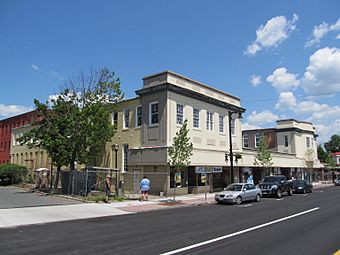United States Whip Company Complex facts for kids
|
United States Whip Company Complex
|
|
|
U.S. Historic district
Contributing property |
|

24 Main Street
|
|
| Location | 24 Main Street Westfield, Massachusetts |
|---|---|
| Area | 2.1 acres (0.85 ha) |
| Built | 1855 |
| Architect | Multiple |
| Architectural style | Italianate |
| Part of | Westfield Center Historic District (ID13000441) |
| NRHP reference No. | 83003983 |
Quick facts for kids Significant dates |
|
| Added to NRHP | November 29, 1983 |
| Designated CP | June 25, 2013 |
The United States Whip Company Complex or "United States Line Company Complex" is a historic factory located in Westfield, Massachusetts. It was owned and operated by one of the whip-making businesses that led Westfield to become widely known as "Whip City". United States Whip, created in 1892 by the consolidation of several local manufacturers, was the world's largest manufacturer of whips. The factory complex was listed individually on the National Register of Historic Places in 1983, and as part of an expanded Westfield Center Historic District in 2013.
Description and history
The former United States Whip Company facility is located in downtown Westfield, on the north side of Main Street (United States Route 20) just east of Park Square and Elm Street, its principal downtown commercial thoroughfare. It consists of seven brick buildings, which occupy most of a city block along with a large parking lot. Building 1, built in 1855, is a large 3-1/2 story building constructed using typical 19th-century mill construction and styling. Building 2 was built sometime before 1884; it is a three-story brick building ten bays long and four wide, from which there is a connector a 1-1/2 story building that fronts on Thomas Street.
Whip making began in Westfield in the early 19th century, and was its major industry by the mid-19th century. United Whip was founded in 1892, and grew by acquiring many of Westfield's smaller manufacturers. At its height in the 1910s, it was the world's largest manufacturer of whips, a business that declined with the advent of the automobile. These buildings were used from 1855 until 1928 for the manufacture of whips. The 1855 building was constructed by United's predecessor, the American Whip Company, and building 2 housed the main corporate offices in addition to manufacturing facilities. After 1928 the building fronting on Elm Street was modified to accommodate retail stores and a theater, to a design by architect Malcolm B. Harding. Portions of the complex have been rehabilitated as residences or offices.



